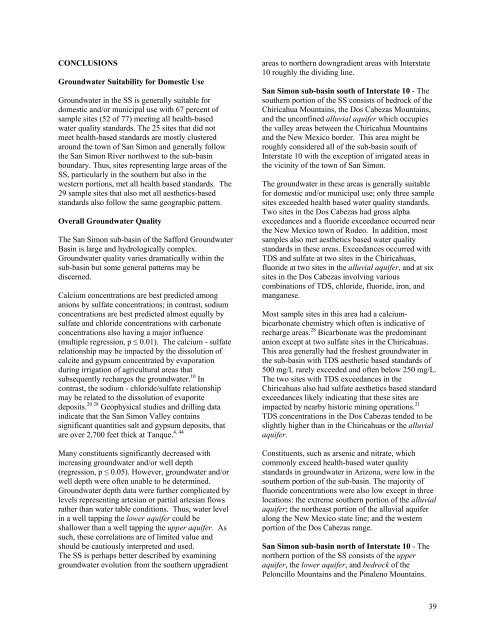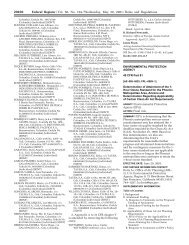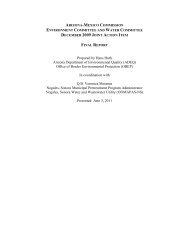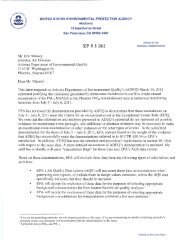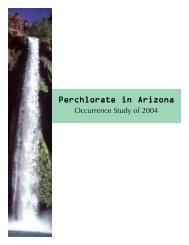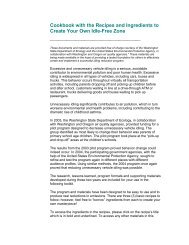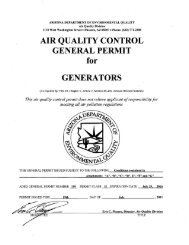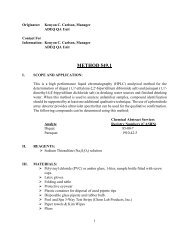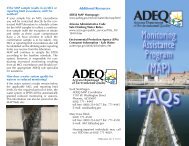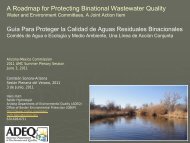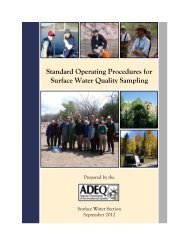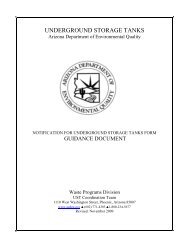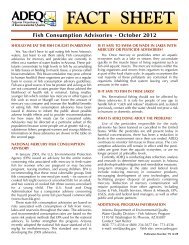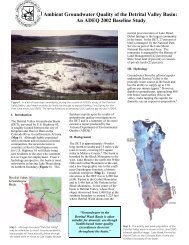San Simon Sub-Basin - Arizona Department of Environmental Quality
San Simon Sub-Basin - Arizona Department of Environmental Quality
San Simon Sub-Basin - Arizona Department of Environmental Quality
You also want an ePaper? Increase the reach of your titles
YUMPU automatically turns print PDFs into web optimized ePapers that Google loves.
CONCLUSIONS<br />
Groundwater Suitability for Domestic Use<br />
Groundwater in the SS is generally suitable for<br />
domestic and/or municipal use with 67 percent <strong>of</strong><br />
sample sites (52 <strong>of</strong> 77) meeting all health-based<br />
water quality standards. The 25 sites that did not<br />
meet health-based standards are mostly clustered<br />
around the town <strong>of</strong> <strong>San</strong> <strong>Simon</strong> and generally follow<br />
the <strong>San</strong> <strong>Simon</strong> River northwest to the sub-basin<br />
boundary. Thus, sites representing large areas <strong>of</strong> the<br />
SS, particularly in the southern but also in the<br />
western portions, met all health based standards. The<br />
29 sample sites that also met all aesthetics-based<br />
standards also follow the same geographic pattern.<br />
Overall Groundwater <strong>Quality</strong><br />
The <strong>San</strong> <strong>Simon</strong> sub-basin <strong>of</strong> the Safford Groundwater<br />
<strong>Basin</strong> is large and hydrologically complex.<br />
Groundwater quality varies dramatically within the<br />
sub-basin but some general patterns may be<br />
discerned.<br />
Calcium concentrations are best predicted among<br />
anions by sulfate concentrations; in contrast, sodium<br />
concentrations are best predicted almost equally by<br />
sulfate and chloride concentrations with carbonate<br />
concentrations also having a major influence<br />
(multiple regression, p ≤ 0.01). The calcium - sulfate<br />
relationship may be impacted by the dissolution <strong>of</strong><br />
calcite and gypsum concentrated by evaporation<br />
during irrigation <strong>of</strong> agricultural areas that<br />
subsequently recharges the groundwater. 10 In<br />
contrast, the sodium - chloride/sulfate relationship<br />
may be related to the dissolution <strong>of</strong> evaporite<br />
deposits. 20 28 Geophysical studies and drilling data<br />
indicate that the <strong>San</strong> <strong>Simon</strong> Valley contains<br />
significant quantities salt and gypsum deposits, that<br />
4, 44<br />
are over 2,700 feet thick at Tanque.<br />
Many constituents significantly decreased with<br />
increasing groundwater and/or well depth<br />
(regression, p ≤ 0.05). However, groundwater and/or<br />
well depth were <strong>of</strong>ten unable to be determined.<br />
Groundwater depth data were further complicated by<br />
levels representing artesian or partial artesian flows<br />
rather than water table conditions. Thus, water level<br />
in a well tapping the lower aquifer could be<br />
shallower than a well tapping the upper aquifer. As<br />
such, these correlations are <strong>of</strong> limited value and<br />
should be cautiously interpreted and used.<br />
The SS is perhaps better described by examining<br />
groundwater evolution from the southern upgradient<br />
areas to northern downgradient areas with Interstate<br />
10 roughly the dividing line.<br />
<strong>San</strong> <strong>Simon</strong> sub-basin south <strong>of</strong> Interstate 10 - The<br />
southern portion <strong>of</strong> the SS consists <strong>of</strong> bedrock <strong>of</strong> the<br />
Chiricahua Mountains, the Dos Cabezas Mountains,<br />
and the unconfined alluvial aquifer which occupies<br />
the valley areas between the Chiricahua Mountains<br />
and the New Mexico border. This area might be<br />
roughly considered all <strong>of</strong> the sub-basin south <strong>of</strong><br />
Interstate 10 with the exception <strong>of</strong> irrigated areas in<br />
the vicinity <strong>of</strong> the town <strong>of</strong> <strong>San</strong> <strong>Simon</strong>.<br />
The groundwater in these areas is generally suitable<br />
for domestic and/or municipal use; only three sample<br />
sites exceeded health based water quality standards.<br />
Two sites in the Dos Cabezas had gross alpha<br />
exceedances and a fluoride exceedance occurred near<br />
the New Mexico town <strong>of</strong> Rodeo. In addition, most<br />
samples also met aesthetics based water quality<br />
standards in these areas. Exceedances occurred with<br />
TDS and sulfate at two sites in the Chiricahuas,<br />
fluoride at two sites in the alluvial aquifer, and at six<br />
sites in the Dos Cabezas involving various<br />
combinations <strong>of</strong> TDS, chloride, fluoride, iron, and<br />
manganese.<br />
Most sample sites in this area had a calciumbicarbonate<br />
chemistry which <strong>of</strong>ten is indicative <strong>of</strong><br />
recharge areas. 28 Bicarbonate was the predominant<br />
anion except at two sulfate sites in the Chiricahuas.<br />
This area generally had the freshest groundwater in<br />
the sub-basin with TDS aesthetic based standards <strong>of</strong><br />
500 mg/L rarely exceeded and <strong>of</strong>ten below 250 mg/L.<br />
The two sites with TDS exceedances in the<br />
Chiricahuas also had sulfate aesthetics based standard<br />
exceedances likely indicating that these sites are<br />
impacted by nearby historic mining operations. 21<br />
TDS concentrations in the Dos Cabezas tended to be<br />
slightly higher than in the Chiricahuas or the alluvial<br />
aquifer.<br />
Constituents, such as arsenic and nitrate, which<br />
commonly exceed health-based water quality<br />
standards in groundwater in <strong>Arizona</strong>, were low in the<br />
southern portion <strong>of</strong> the sub-basin. The majority <strong>of</strong><br />
fluoride concentrations were also low except in three<br />
locations: the extreme southern portion <strong>of</strong> the alluvial<br />
aquifer; the northeast portion <strong>of</strong> the alluvial aquifer<br />
along the New Mexico state line; and the western<br />
portion <strong>of</strong> the Dos Cabezas range.<br />
<strong>San</strong> <strong>Simon</strong> sub-basin north <strong>of</strong> Interstate 10 - The<br />
northern portion <strong>of</strong> the SS consists <strong>of</strong> the upper<br />
aquifer, the lower aquifer, and bedrock <strong>of</strong> the<br />
Peloncillo Mountains and the Pinaleno Mountains.<br />
39


